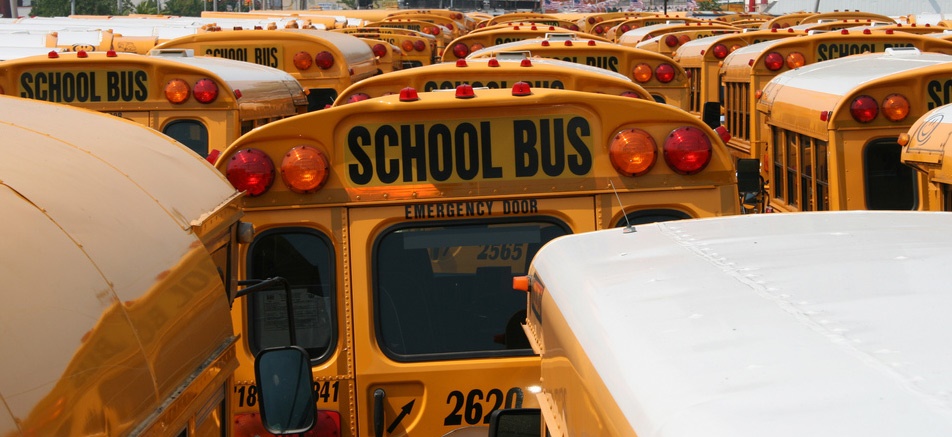Taking Aim at Voucher Schools
A JS reporter’s story details disturbing problems -- but not in her own newspaper.
A recent, in-depth story in the liberal American Prospect, “Milwaukee’s Voucher Verdict,” raises troubling questions about choice schools. Curiously, it was written by Milwaukee Journal Sentinel Erin Richards while she was on leave from her job, and nothing like it has been published in the newspaper. Even more curious, Richards was the reporter that then-Milwaukee School President Michael Bonds wanted the JS to remove from the education beat, and yet her story if anything suggests more sympathy for public schools.
But it would be a mistake to pigeon hole the story, which is thoughtful, broad in sweep and ultimately a very disturbing look at a Milwaukee education scene where not much seems to be working. Richards begin with a description of the Ceria M. Travis Academy, a fly-by-night K-12 choice school where a teacher was given no curriculum, few books (one out of date) and where just “one student scored at least ‘proficient’ in language arts on the latest state exams, and none were proficient in math, science, or social studies.”
That a school like Travis Academy has been in operation for two decades, Richards writes, calls into question the philosophy behind private school choice, that “Introducing competition to the government monopoly on public schools will lead to higher academic performance.”
From there the story makes many punchy observations, including:
-The 2010 wave election that brought in many Republican-run statehouses has greatly increased voucher programs, growing from 15 states and 24 programs that year to 28 states and 61 programs in 2016, with some voucher programs now reaching beyond low-income students to include the middle class.
-Public money for vouchers doesn’t require much public information. Voucher schools in Wisconsin, “thanks to expansions signed by Republican Governor Scott Walker since 2011—are not compelled by law to hold public meetings or disclose high school graduation or dropout rates. They are not obligated to make public any data on student suspension or expulsion or attendance rates, or any information on teachers, from salaries to absenteeism to a simple roster.”
-Though vouchers were supposed to improve education in Milwaukee, choice schools on average do about as poorly as public schools, and the exceptions among choice schools have tended to be Catholic and Lutheran schools, “which would have never maintained a presence in the inner city serving poor children without taxpayer assistance.”
-There are no state policies in Wisconsin that aim to expand good choice schools and shut down the many dreadful schools because “choice advocates don’t want to give more power to the Wisconsin Department of Public Instruction,” which is seen as an advocate of public schools.
-The minority of voucher schools may benefit from weeding out difficult students. Many have stringent discipline policies that allow expulsion for vaguely described offenses. “Grade promotion records… revealed many voucher schools had a student population that dramatically diminished as the grade levels advanced.” The most robust study of choice schools found “more than half the students who started ninth grade in a voucher high school were not still there by 12th grade.” (And when those students leave, they can by law go back to Milwaukee Public Schools.)
-Higher-performing choice schools tend to attract more parents “who are well equipped to make educational decisions.” To enroll at St. Marcus Lutheran, a showcase school for voucher success, parents have to “sign a covenant agreeing to get their child to school on time and to oversee homework… agree to sit down with teachers in their home at least once a year, and attend parent-teacher meetings. And they have to find their own transportation, as St. Marcus does not provide busing.” Public schools can’t make such requirements.
-The disappointing results of voucher schools, instead of triggering calls for change, have simply shifted the rationale for them. “Instead of being championed as a panacea for failing urban schools… choice is now being positioned as a fundamental right that should be guaranteed to all families.” (Republicans, I might add, have also increasingly justified them as cheaper than public schools.)
-As more states have approved voucher programs nationwide public support for them has fallen. “Between 2012 and 2016, nationwide public support for vouchers targeted at low-income students fell from 55 percent to 43 percent.” Interestingly, the support for vouchers was higher among Democrats than Republicans.
-As Wisconsin led the way in choice schools, other states put more emphasis on charter schools. That seems like a great misfortune. For what Richards’ story strongly suggests (and high-profile voucher supporter Howard Fuller concluded at least a decade ago) is that giving low-income parents the power to choose their child’s school does not result in bad ones being rejected. Quite the contrary.
In short, it appears we need the “nanny state” or some form of government oversight, which is what you get in charter schools: In Milwaukee that could be city government or UW-Milwaukee, for instance, that operate as the chartering authority. As Urban Milwaukee columnist and former Milwaukee School Board member Bruce Thompson has concluded, charter schools that are independent of MPS have had pretty promising results.
We might have had many more of these independent charter schools if not for the all the GOP political pressure and conservative Bradley Foundation funding for choice schools.
I supported school choice as an experimental program back in 1990, but the experiment has gone on for 27 years and choice schools in Milwaukee now constitute what amounts to the second largest school district in the state. And there is no evidence that education in Milwaukee has improved as a result. At what point will this be recognized by state and local policymakers? Clearly we need a new approach.
Richards completed this article while on leave from the Journal Sentinel, and with support from the Spencer Fellowship in Education Reporting at Columbia University. It’s certainly timely, given President Trump’s promise to spend $20 billion in federal funds on choice and charter schools. The experience of Milwaukee, the national trailblazer for vouchers, strongly suggests choice is not the way to go.
The brief controversy over Richards’ reporting in Milwaukee, which arose in the fall of 2014, was reported by Urban Milwaukee and was something of a comedy of errors. There is little evidence anyone with MPS besides Michael Bonds was pushing to replace Richards. And the idea that she has it in for public schools is hard to square with her American Prospect piece.
Of course, reporters like Richards must deal with editors, who can sometimes shape the direction of stories. Beyond that, the conventions of daily journalism, with the inverted pyramid narrative and “balanced” reporting, can often result in murky stories that leave readers with more questions than answers. Richards tells me she hopes to do a two-part article on some of her findings for the Journal Sentinel. I doubt it will be as incisive as this story.
If you think stories like this are important, become a member of Urban Milwaukee and help support real independent journalism. Plus you get some cool added benefits, all detailed here.
If you think stories like this are important, become a member of Urban Milwaukee and help support real, independent journalism. Plus you get some cool added benefits.
Political Contributions Tracker
Displaying political contributions between people mentioned in this story. Learn more.
Murphy's Law
-
Is Legislature Biased Against Working Class?
 Apr 4th, 2024 by Bruce Murphy
Apr 4th, 2024 by Bruce Murphy
-
Associated Press Will Decline in Wisconsin
 Mar 27th, 2024 by Bruce Murphy
Mar 27th, 2024 by Bruce Murphy
-
City Attorney Race Is Vitally Important
 Mar 25th, 2024 by Bruce Murphy
Mar 25th, 2024 by Bruce Murphy


















“…and choice schools in Milwaukee now constitute what amounts to the second largest school district in the state.”
I think that is really insightful and very much underappreciated in the rest of the state. However, do you have any numbers to back up this claim?
I’ve heard the ‘All-you-did-is-create-a-new-underfunded-and-unaccountable-system’ argument before, but with politics the way they are it really hasn’t had a fair hearing. Not that it would matter much. Everything is too overwrought with emotion, ideology, and pecuniary interest for any worthwhile education reform to happen. Anyways, thanks for the point to the article. I’m looking forward to reading it.
The most curious aspect of this important story is that while Erin had the beat for JS, nothing like this came into print. I never understood Bonds picking her out, because the responsibility should like with the editors and there is no way to determine what or when she fought for.
“To enroll at St. Marcus Lutheran, a showcase school for voucher success, parents have to “sign a covenant agreeing to get their child to school on time and to oversee homework… agree to sit down with teachers in their home at least once a year, and attend parent-teacher meetings. And they have to find their own transportation, as St. Marcus does not provide busing.” Public schools can’t make such requirements.”
My understanding is that deviation from the covenant results in expulsion from the school. Constant cherry-picking of the best of the best students is what led St. Marcus to this lauded position. Given St. Marcus does not have to reveal who has been expelled or in what numbers, they have a huge advantage over public schools.
Michigan, home to Betsy DeVos and big into charter schools, has a “report card” available for all schools. It’s nice to have data when you make pronouncements.
http://www.mackinac.org/depts/epi/performance.aspx
You can filter for type of school (HS vs elementary) or look at a county-wide result. Here are Detroit Public Schools high schools, for example.
http://www.mackinac.org/depts/epi/performance.aspx?count=100&report=2&CCode1=All+Counties&DSearch1=&DCode1=82015&SSearch1=&SCode1=All+Schools&year=2012-2015&subject=Overall&locale=All&type=All&sort=Overall+CAP+Score#topofform
Here are all high schools where you can compare charter and other types:
http://www.mackinac.org/depts/epi/performance.aspx?count=100&report=2&CCode1=All+Counties&DSearch1=&DCode1=All+Districts&SSearch1=&SCode1=All+Schools&year=2012-2015&subject=Overall&locale=All&type=All&sort=Overall+CAP+Score#topofform
We all know that New Jersey Sen. Cory Booker (D) was no fan of Education Secretary Betsy DeVos, and spoke out quite vocally against her confirmation. What don’t all know is that at the American Federation for Children, the group chaired by DeVos at the time, Booker spoke passionately and earnestly about the importance of school choice to get kids out of bad schools in New Jersey cities.
“I cannot ever stand up and stand against a parent having options, because I benefited from my parents having options. And when people tell me they’re against school choice, whether it’s the Opportunity Scholarship Act or charter schools, I look at them and say: “As soon as you’re telling me you’re willing to send your kid to a failing school in my city [Newark, N.J.], or in Camden or Trenton, then I’ll be with you.” . . . I’m going to be out there fighting for my president, but he does not send his kids to Washington, D.C., public schools. I got a governor in the statehouse, he does not send his kids to Trenton public schools. I could go all the way down to city council people in Newark, that do not send their kids—so what have we created? A system that if you’re connected, elected, have wealth and privilege, you get freedom in this country? And now you want to deny that to my community? No. I am going to fight for the freedom and the liberty and the choice and the options of my people, in the same way you will defend that right for yourself.”
So, it appears that this is not about “schools of choice” or charter schools or even Betsy DeVos. It’s all about a visceral reaction to Donald Trump and anyone to whom he gives support.
I tried to provide links to some good information… data… about Michigan schools, but unfortunately this comment section seems to reject links.
Neither Cory Booker nor Betsy DeVos are credible sources about anything relating to school choice–or education in general. And DeVos does not even know the basics about how education, especially in public schools. One of her goals is to increase the number of religious schools receiving public money.
Here’s an article about how Newark frittered away hundreds of millions on their “experiments.”
https://www.nytimes.com/2015/08/23/books/review/the-prize-by-dale-russakoff.html
Mackinac is a very conservative group that supports school choice right Bruce? Also, plenty of people, like Eli Broad, and not just Booker, are against DeVos because she is unqualified for the job. She had no idea what the difference between growth and proficiency is. She didn’t know that all schools that receive federal funding must meet IDEA requirements. One could go on and on.
@Bruce Hall, your links came through.
Also, it is important for everyone to note that not all charters or vouchers are created equal, so using the terms across the country often means you’re referring to completely different things and thus distorting the discussion.
For example, the “Blaine Amendment” actually makes “vouchers” illegal in DeVos’ Michigan, so all they have are charters…but, she’s got a pretty consistent record of pushing for lower accountability standards in those schools.
Here in Wisconsin, we have charters and vouchers. Vouchers, on the whole, are generally worse on a number of measurements than charters do — yes, there are good examples in each, but no sustainable model. This is because the chartering authority (currently limited to an educational facility itself, like MPS, MATC, UWM, etc) is usually watching their charters a bit more closely, but the standards are still lax compared to the public school system. Vouchers are the ones that get to kick the kids out (and keep the money!), charters do not have as much leeway here.
If the desire for competition and choice is strong, then what the debate should focus on is the ability to compare, which means maximum transparency. We should expect nothing less than this of any destination of tax dollars.
However, let’s not forget that the public school system still has the majority of the students and retains a large portion of its fixed costs, so simply taking money away from it is likely not a recipe for success.
For those who object to the Mackinac Foundation because it is conservative, I’m just providing comparable data for all schools in Michigan, not arguing that one district is superior to another because of political philosophy.
To me, what the data show are that there is a wide dispersion of performance in both public and charter schools. Interestingly, it is fairly easy to get rid of poorly performing charter schools; just a matter of revoking their charter. Public schools, on the other hand, have gotten a complete pass with no public school, to date, having been closed because of performance issues.
@Rich “For example, the “Blaine Amendment” actually makes “vouchers” illegal in DeVos’ Michigan, so all they have are charters…but, she’s got a pretty consistent record of pushing for lower accountability standards in those schools.”
Actually, under schools of choice, students from one district may choose to attend schools in another district. Our own district has approximately 10% of its enrollment from other districts. Students are not bused, however. But otherwise they receive all the benefits of students within that district, including free lunches if they qualify. Incidentally, there are no charter schools in our district which has about 7,000 students. All of our public schools are rated C or higher in the Mackinac database. Our funding per pupil is about 2/3 that of Detroit Public Schools.
Catholic and Lutheran schools, “which would have never maintained a presence in the inner city serving poor children without taxpayer assistance.” How many thousands of Milwaukee residents would not maintain a presence in Milwaukee without tax payer assistance. It’s tuition — whether it’s paid to public or private schools, who cares. They key to good education is parental involvement, NOT SCHOOLS. Voucher parents are slightly more involved – a net good. You can’t BUY a good education because students are not computers and teachers are not programmers.
Inflation adjusted costs for K-12 education versus enrollment. An interesting graphic.
http://s3.amazonaws.com/cdn.liberallogic101.com/wp-content/uploads/2017/02/C4FowH7UYAAbPLu.jpg
Part 1 of what I have written is complementary to Ms Richards but it looks Part 2 deals with the WHY we have Choice Vouchers Charters etc Until anyone deals with the WHY nothing will change.
A Millstone Around Our Necks
By: Thomas Spellman May 31, 2014 — May 11 2015 – February 3 2017
PART 1
I will use RIGHT as a broad description of those forces who have orchestrated the placement of the millstone.
The NEA and the AFT and most, if not all, of the state education associations have a millstone around their necks, and they have not be able to figure out what that millstone is nor how to get rid of it. They know it is there because of the incessant Legislative Action taken against public education and Teacher Unions in particular. There is a history about the placement of the millstone, but because it has been a slow and systematic process, it is hard to pinpoint when it started.*
The current phase of the effort to place the millstone started by their own admission in 1989 in Milwaukee, Wisconsin, with just a few hundred children who were poor and black (other minority children were included but few participated). It was represented to the public that these poor black children did not have the same “advantage” as the white children in Milwaukee, and so the Parental Choice School program* was created by the Wisconsin State Legislature to allow poor minority (black) children to attend a school of their parent’s choice which in essence meant attending a Religious school if it was going to be a better school. All those children already had the right (with just a little luck) to go to any Suburban School through the Court desegregation order. Thousands of children graduated from those Suburban School but no follow up on their success has ever been published. The program was killed by Walker and the Republican Legislature almost without comment in the Local Press.
As with all “big” City school systems, in 1989, the poor black children who attended Milwaukee’s Public Schools (MPS) did not do as well as their white counterparts. In fact, a disproportionate number of the black children, primarily young black male children, were not learning, were not graduating from high school, and so this became the MORAL basis for the Parental Choice School program. The Parental Choice School program would provide poor black children a chance to attend better if not good schools. It is important to understand that the black children NOT LEARNING, NOT GRADUATING was the MORAL basis, the foundation, of the Parental Choice School program. It is CRITICAL to understand that black children NOT LEARNING, NOT GRADUATING, TODAY, STILL IS the MORAL basis for, not only Wisconsin’s Voucher, Charter and Parental Choice School programs, but, the whole National Charter School movement as well.
The RIGHT (accidentally or by design) has successfully tied the millstone not only around the necks of the teacher’s Unions but also around the neck of Public Education itself! Yes the millstone can be seen as the failure of Public Education to graduate tens of thousands of young black males, who as we know do not have good outcomes in their lives if they do not graduate.*
Dr. Howard Fuller (Milwaukee activist) and others claimed that it was the FAULT of Milwaukee’s Public Schools (MPS) that those poor black children were not learning, and it was also the FAULT of the Milwaukee Teacher Education Association (MTEA) that kept “bad” teachers teaching, so both Public Education and teachers and the Teacher’s Union were BAD, and the millstone was attached to all!
And so here we are today trying to figure out WHAT TO DO. Mind you that we have been trying to figure out WHAT TO DO for the past thirty plus years.
This begs the question of WHO should have figured out what was happening and WHO should have directly addressed the MORAL issue of black children (young black male children) not learning. Not only were they not learning but their failure were being ignored as well!! To be fair there surely have been efforts made to address young black males not learning, not graduating and yet as we all know much of that effort have been for naught.* I will leave for others to figure out the exact history of who did or did not make the critical observations that you will see are in the final analysis, relatively simple and very basic.
Now that we know what the millstone is – the MORAL concern that black children not learning, not graduating, is the BASIS for “change.”
Before we examine the ways to remove the millstone let us first understand WHY the millstone has been attached to the necks of the Teacher Unions and Public Education itself.
Now the RIGHT does long range planning and the millstone around the neck of the Teacher Unions and Public Education is the perfect example of their planning. It either starts with Howard Fuller efforts of creating Voucher Schools for Milwaukee’s black children or sometime before but as Fuller admitted in 2013:
“When I (Howard Fuller) got into this battle in 1989, standardized test scores showed Milwaukee was failing to educate poor black children. That’s when state Rep. Annette Polly Williams courageously stepped forth to make sure that poor families were afforded some opportunity to choose schools in the private sector for their children. She shepherded the pioneering voucher program through the Legislature.”
“Since then, I, along with many others, have fought tirelessly for parental choice for low-income families throughout the nation. The governor’s plan (Governor Scot Walker) would turn Milwaukee’s program into something it was never designed to be.”
Please note that Dr. Fuller says he started working with Rep. Polly Williams in 1989 but he does not become the Superintendent of MPS, the largest Public Schools system in Wisconsin, until 1991 and holds that job for 5 years while cutting all of the manual arts classes out of the High Schools and not dealing with black male not graduating.
So in the name of black children who were not learning, (the MORAL failure of society) Dr. Howard Fuller began the systematic attack on the Teachers Unions and on Public Education itself. The RIGHT supported Dr. Fuller, and Representative Annette Polly Williams and they became the mechanism to attack the MTEA and MPS. That was the a step (the first step?) in the plan to privatize Public Education*.
It needs to be noted that research addressing why young black children and young black males in particular were not learning would have been the MORAL action to take but the RIGHT made sure that institutions (Public Education and Teacher Unions) that are the people’s voice would be systematically attacked and destroyed.
It has been pointed out, by others, that while privatizing prison is a major source of cash for corporations, Public Education is the real CASH COW.* Not only is the RIGHT looking at the primary and secondary schools but at the Public Universities as well. If WE and that includes those closest to the battle, the Teacher Unions and Faculty at Public Universities, do not wake up we will see an education system as it was in the 1800’s. Oxford, Harvard and the like for the rich and not much else for the rest of us. While in the 1800’s servants were needed to support the life style of the rich, now they will have robots who do not need sick leave and are always clean, so who will need the workers. That is the direction we are headed and that is how the cards are currently stacked. The corporations of the world are salivating and just waiting for the right time to take over the Public Education system of United States.
Thirty years ago when Dr. Howard Fuller spoke and when Annette Polly Williams spoke everyone understood that the basis for the attack of the Milwaukee Public Schools (MPS) was the FAILURE of MPS to
educate young black males.
Yes, and what has been the response of those being attacked by the RIGHT? The teachers themselves and the Teacher Unions have rightly claimed that they are not the cause of the failure of young Black males not learning not graduating and by any applied logic* they are NOT. Recently as an effort to support Public Education the Wisconsin Education Association Council (WEAC) ran a campaign calling for “Great Schools” for all children in Wisconsin. They DID NOT address the MORAL issue of black children not learning, not graduating and hence the campaign fell on deaf ears because everyone knew that the black children DID NOT HAVE and WOULD NOT HAVE “great schools” and NO ONE was addressing the fact that a significant percentage of black children were not learning were not graduating.
While the Teacher Unions have Presidents and public relations staff to express the views of their members, WHO SPEAKS FOR PUBLIC EDUCATION? Yes as Dr. Seuss asks, WHO speaks for the trees? The concept of “Public Education”, has been commandeered by the RIGHT, to mean Central City Black Education. The simple proof of that is that there are thousands of high performing schools in the U.S. that are PUBLIC SCHOOLS. PUBLIC SCHOOLS WORK and yet the RIGHT has convinced many Americans that PUBLIC SCHOOLS and therefore PUBLIC EDUCATION is broken, and therefore needs to be FIXED and SAVED, by associating public education with central city education which is equated to the education of black children.
Most unfortunately, for the children, there has been lots of hand wringing but NO RESULTS. While the numbers of black children who fail may be lower today than 30 years ago, the effects of today’s failures still haunts not only the immediate community but the cities themselves. The violence, the senseless deaths, in our large cities is horrifying and YET there is NO VISION of how to address the MORAL FAILING that young Black males are not learning, not graduating! The one seems to be unconnected from the other when in fact they are JOINED at the HIP!
PART 2
How do we proceed? We know that the millstone is a MORAL concern, the failure to educate black children primarily young black male children. Yes that is the millstone but what causes black children and in particular young black males to fail? That is the question that Dr. Howard Fuller and our Universities, Public and Private, should have addressed 30 years ago and it’s still the question that needs to be address today.
As an observer of education, primarily Milwaukee and Wisconsin, for the past 40 years I have pieced together a few observations that others have not. What I know for sure is that by not addressing the moral issue, we have now failed two generations of black children.
Observation one
All learning is individual. While we teach children in groups, each child’s learning is dependent not only upon their cognitive abilities but also on their behavioral abilities. We know that we have various test to determine a child’s cognitive abilities. We will know a child’s behavioral abilities, disposition, by observation. If the child’s behavior is cooperative and inquisitive we know that there is a very good chance that that child will reach their cognitive potential. If on the other hand the child’s behavior is angry or belligerent we know that, that child will probably not reach their potential. Behavior is a/the key to learning. As we know cooperative behavior is assumed of all children attending public schools. Unfortunately many children are not cooperative and the Schools are not prepared to deal with children who are not cooperative and in fact who are angry or belligerent. (As we will see it is this failure that is the basis of the MORAL concern.)
It should be noted that successful schools are dependent upon each child’s success! Schools fail because STUEDNT FAIL, Schools succeed ONLY when STUDENTS SUCCEED!
Observation Two
Because it is often easier to see the differences when using two extremes let us examine and then compare two high schools, one that “works”, and by that I mean graduates almost all of its students 4 year later and many of those graduating students go on to college, and one that does NOT “work”, one that has a high dropout rate and few students go on to college. What do we see? Are there any clues or maybe even answers as to why some schools and again it is the children who determine if a schools is “successful” and why some schools and again it is the children who determine if the school is NOT “successful”?
You can mentally run through all the differences between the two schools.* I ask you to focus on the behavioral differences between the two schools. Yes the “attitude” of the hallways and the number of suspensions/expulsions and that should begin to tell the tale.
The reading ability of the children between those two schools will also be different but that is an indicating that the problem starts at an earlier age and not in the high school. Yes it starts in first grade and yes it starts in the home before that and gradually builds as the behavioral issues are first squashed and then with age become unmanageable. Even though it may start in the home it still is in Society’s interest to address it ASAP and it is that failure that leads us to where we are today. If it is about the behavior then where and how can it be addressed?
I suggest that there is a direct correlation between schools with high suspension/expulsion rates, and schools that are failing. We need to examine the children who are being suspended/expelled to understand why they are failing, why they are not succeeding and therefore why the school they attend is failing!!
Observation Three
Let us also look at a process that a friend who was a teacher and a principal uses with teachers he is consulting with. After the teachers have had their students for a month or so he asks them to think of the students in their classroom. He then ask them to first identify the ones that are the perfect students. They are always on task and cooperative, they are a joy to be with. Then to see those student who are almost as good and all they need is an occasional nudge. Then to see the students who need occasional reminders to stay on task and maybe help with a subject or two. The fourth group are those who are struggling but respond. The fifth group of students are those who act out who are contrary who at times are belligerent. It is this group that controls the behavioral atmosphere of the classroom. It is this group of students that can determines what the others learn.
When the teacher has completed the reflection they see their classroom in a way that they may not have seen it before. They will see where their energy goes and also where help is needed. As we know all too often no help is available to help those students who are behavioral challenged.
Observation Four
As I see it, there are two sides of the equation for quality education – the academic side and the behavioral side. As I have suggested above let us examine the behavioral side to see if it bears fruit.
The controlling element on the behavioral side may seem at first not to be that important. I have come to the conclusion that the unresolved abuse/trauma that some children suffer is the controlling element for the dysfunction of the child. We know there is unresolved abuse/trauma because we see the belligerent behavior which results in the classroom disruptions, the suspensions, and the expulsions.
Some will argue that part of those disruptions are the fault of the “ineffective” teacher, but that begs the question because surely not all of the disruption (i.e. belligerent behavior) is the result of “ineffective” teaching/teachers.*
The work of Dr. Lonnie Athens lays out very clearly that unresolved abuse/trauma that leads to brutalization is the foundation to all violent behavior. What Dr. Athens also observed, and is critical for all educators AND ALL OF US to understand, is that all abused/traumatized individuals who have NOT RESOLVED their abuse/trauma will become belligerent – will become so angry that they begin to act out. That acting out is either external – against others – or internal – against themselves. Dr. Athens studies looked at those acted against others, who murdered and raped.
What is critical to understand is that the belligerent behavior must NOT be seen as an affront to authority BUT SEEN as a child’s CRY FOR HELP. The “CRY” is no different from a baby’s cry. In large part we know how to respond to a baby’s cry. WHAT WE DO NOT KNOW, IS HOW TO REPOND TO A CHILD’S BELLIGERENT BEHAVIOR. We need to learn how to positively respond to a child’s belligerent behavior!!
This one change has the potential to change many if not most of the abuse/trauma outcomes.
First to see the belligerent behavior as a cry for help and then to understand that the student’s UNRESOLVES abuse/trauma must be resolved.
Also we respond very differently to a person who is crying for help, than one, who seems to us to be challenging our authority or more basically our safety.
Dr. Athens’ work is most easily understood in Why They Kill written by Richard Rhodes. In Chapters 10 and 11, Rhodes explains Athens’ theory. Unresolved abuse/trauma is the underlying cause of violent behavior and all who are first abused/traumatized become belligerent before they become violent. The first nine chapters of the book are a biography of Dr. Lonnie Athens which explains how he came to understand what he was observing, as he did his research with prisoners who had committed violent crimes.
Below are two real-life examples of the effects of abuse/trauma.
A friend who was an assistant principal at a middle school could set her watch when a girl would come into her office. Finally, she told the girl that they needed to have a long talk before lunch. After a long pause the girl blurted out that her brother had died from sickle cell anemia. Before the assistant principal could get her arms around the girl to hold her, the girl further revealed that she, too, has sickle cell anemia. She did not know if or when she would die, and her family had not listened or responded sufficiently to her cries for help. Most would deem this, the family’s responsibility, not the school’s responsibility. But the girl was failing, the girl was disruptive, and so it became the school’s issue. Her UNRESOLVED trauma (loss of her brother) needed to be resolved for her own good as well as the good of the school and MPS itself.
The other story is one told by a social work who took time to listen to a boy who was doing good work, but then in a very short period of time, things fell apart. As the boy talked, it came out that he was homeless in that they had moved in with relatives, and he was sleeping in the basement. But that was not the problem. The real issue was that he did not have a blanket to cover himself. This so upset him (traumatized him) that he became belligerent. Once a blanket was provided, he went back to doing good work once again. It is easy to see how this story could have ended without the blanket.
These two stories represent a far greater number of stories of our children. Some of the stories will be horrifying to say the least. How schools and school districts responds to the stories is key for both the child’s success or failure, and therefore, the success or failure of the schools themselves. What we know for certain is that the vast majority of the children who are being suspended in the elementary grades are children in dire need of social services (i.e. therapy). It is critical to first figure out what is troubling each child and then to find the resources either inside the school or through other agencies to address each child’s issues.
WHO speaks for the children??
Can we all be agreed that a child’s inappropriate behavior – belligerent behavior is what needs to be focused on? It is the inappropriate behavior – belligerent behavior that begins the process of suspensions which for some (many) leads to dropping out and the rest of the litany that leads to violent crimes and then jail or death. Have we ever thought that just maybe the belligerent behavior is not directed as an affront to authority?
The question before us is clear
1) Is, a child’s belligerent behavior, an expression of the child’s WILL (having nothing to do with past abuse/trauma)?
OR
2) Is a child’s belligerent behavior a response to unresolved abuse/trauma that the child has experienced (suffered)?
These two statements are diametrically opposed. Either a child’s belligerent behavior is personal and intentional (mindful) or it is a response to the unresolved abuse/trauma that the child has experienced.
Which is it? How do we determine this?
We have for years approached a child’s belligerent behavior as a personal and intentional act. That the child WANTS to be disruptive enough so they can be suspended from school etc. Schools have tried to control and change the belligerent behavior without realizing that there is something that is causing the behavior. What is causing the belligerent behavior? (A medical analogy – Stomach Ulcers – Always known to be cause by stress No doubt! Then a Doctor who thinks, who scratches his head and takes a known virus that he knows causes stomach ulcers and then cures himself with antibiotics.)
It is not understood that for many/most children, their belligerent behavior is a “cry for help” to resolve the unresolved abuse/trauma that he/she has or is experiencing, not an affront to authority much less a threat to their personal safety.
This one change in how a child’s belligerent behavior is understood and dealt with produces significantly different outcomes for the child, the students in the classroom, the teacher, the school and even the family.
A way to look at this is that the belligerent behaviors is a symptom of a problem IT IS NOT the problem. Another way to look at it is the belligerent behavior is like a fever, we know that if we only treat the fever the person will in all likelihood not get better and in fact may die because the real cause of the fever is not being treated.
So to, today, most of the children who are belligerent, have issues of unresolved abuse/trauma, the underlying cause for the behavior, and those issues are not being addressed and so the anger turns to rage and rage turns to violent behavior.
Understanding Failing Schools,
Understanding Schools that are not succeeding is like learning a NEW computer program. At first it all seems very complex and yet once you have learned the program, it is, hopefully very easy to use. That is the complexity of what we are dealing with. Some of the elements have been identified it is the understanding of the elements that at first seems complex yet once understood it is in fact easy but still lots of WORK.
What are the elements of this new language?
A) Suspension – We know about suspensions. Kids do stuff that breaks the rules, disrupt others and or endanger others or themselves and they get warned and finally they get suspended for a few days.
B) Another name for the “stuff” that kids do to get suspended is Belligerent Behavior. The word “belligerent” is in and of itself very descriptive of the process.
C) Belligerent behavior is the expression of UNRESOLVE abuse/trauma (This may be new) It is critical to understand this because it is the foundation of all violent behavior
D) (This is new) It is in the telling of the story of the unresolved abuse/trauma that begins the healing process and brings the help that is needed to address the unresolved abuse/trauma.
E) The abuse/trauma can be as simple as a young boy not having a blanket or as horrific as a girl of 11 being raped by her uncle for 2 years and then by her cousin for another 2 years. The boy got his blanket because a teacher took the time to ask him WHY he was so upset and to LISTEN to him. The girl of now 15 was not as lucky, she raged all through high school but NO ONE ASKED WHY! NO ONE LISTENED because they ALL KNEW THAT SHE WAS A SPOILED RICH KID.
These are the elements, it is first understanding them and then applying them that leads to proficiency!!
Two additional note:
Circles/Classroom Meetings
If I am right that abuse and the honor code (not covered here) are significant issues that must be worked on and eventually resolved for MPS to be successful, then what can be done in a classroom or school to be effective? I know a leap.
William Glasser in his book Schools Without Failure has one specific suggestion which he explains in detail. Chapters 10 – 12 describe what he calls “classroom meetings”. Today they are called “circles”. He provides the detail necessary to have a good understanding of what takes place in a classroom meeting and how it will benefit the individual student, the class itself, and therefore the school. The abuse/trauma issues will come out in these classroom meetings. Some of them will be simple to fix while others will be very involved and more difficult to resolve. Support for unresolved or difficult issues can be sought with the help of the principal, school social workers or outside partner agencies.
The second one is summarized by Jessica Alexander who wrote The Danish Way of Parenting who notes that in Danish Schools there is a time (an hour) set aside each week for the sole purpose of discussing “issues” that are of concern to the students themselves. What the author noted is that “What many don’t realize is that empathy is a learned skill that many of us miss out on in America” She goes on to observe “Notably, in the Danish education system empathy is considered as important as teaching math and literature and it is woven into the school’s curriculum from pre-school through high school”
Yes here is what we can and need to do to begin to be sure that ALL our children graduate from high school.
I am not an academic nor am I Chris Hedges, so please bear with me here.
Thomas Spellman 210 N 2nd St Delavan WI 53115 414 403 1341
* There are a number of issues that I will only make reference to.
Is comparing your distract to Detroit’s an apples to apples comparison though?
The question has been raised whether the funding comparisons between Detroit Public Schools and our school district are “apples to apples”. Answer: yes.
https://dl.dropboxusercontent.com/u/33425283/School%20Funding%20Comparison.JPG
Detroit has 90% of its students on federally funded lunch program; our district has 15-20%. But our district receives less than $300 per pupil from federal funds while Detroit receives over $5,100. Additionally, Detroit receives $900 per pupil more from the state than our district. Finally, Detroit Public Schools received over $600 million in a bailout from the state in 2016.
But money has not purchased performance in Detroit. http://www.freep.com/story/news/education/2017/01/20/michigan-school-closings-list/96818968/
Detroit Public Schools, though funded better than 99% of other districts, generally have failed by most performance measures (note that the Mackinac database adjusts for economic disparity among the districts so that districts with lower income students get an upward adjustment in their ratings).
Money has simply purchased corruption and bloated bureaucracies in DPS.
http://www.freep.com/story/news/local/michigan/detroit/2016/05/07/corruption-schemes-ran-deep-dps/83932126/
http://michiganradio.org/post/culture-corruption-detroit-public-schools
Yet many cling to the notion that for-profit means corrupt and poor performing.
Bruce, that graph is wrong.
If you’re comparing against 1970 figures, then by definition, 1970 should be 100%, not 0%.
CATO Institute needs to stop with the deceptive graphics.
@ Bruce Hall – I’d be interested in seeing the data behind the graphic you posted, since it comes from the Cato Institute, a well-known conservative group founded by Charles Koch.
“Detroit has 90% of its students on federally funded lunch program; our district has 15-20%.”
This proves you completely wrong Bruce. Considering the role of poverty in education, that means in no way is it an apples to apples comparison. You are clinging to a misguided notion.
@happyjack27: I seem to remember from grade school that when you graph percentage change from a starting point, the starting point is always zero. But you may have gone to different school system.
@ Vincent Hanna: The data between districts are comparable because the performance has been weighted for the percentage of students from low-income homes. This means that a Detroit school with an unadjusted score of 80 might have an adjusted score of 95 while a school where students come from wealthier homes would have have its score reduced from the raw score.
@Big Al: This is the article from which the original graphic was published: https://www.cato.org/blog/public-school-spending-theres-chart
If you read the sources alongside the first chart, I believe your question will be answered.
Remember: these are data, not political arguments. They are also not representations of underlying issues that other commenters have listed such as parental involvement, attitudes, and school environment (administrative competence, support for teachers, etc.).
I’m pleased if this has challenged your preconceptions.
Now that you’ve had a chance to look at the ranking data, for those of you who are truly interested, here is an explanation of the scoring which is adjusted for factors such as student income. Data and methods begins on page 5. This is not dissimilar to the NOAA adjustments to the raw temperatures for externalities.
https://docs.google.com/viewer?url=http%3A%2F%2Fwww.mackinac.org%2Farchives%2F2017%2Fs2017-01.pdf
@Bruce
I don’t think they teach that kind of thing in grade school. But if that’s what they really taught you in grade school, then I feel bad for you – you got jibbed.
@Bruce
regarding “adjusting” for income, that’s not how you’re supposed to do it.
You’re supposed to do a factor analysis.
https://en.wikipedia.org/wiki/Factor_analysis
Not simply using average income in the factor analysis would be insufficient – since % on school lunch is going to be related to % below a certain threshold of income, which is not going to be linearly related to average income. Instead you’d have to specifically add in % below that threshold. For which I’m pretty sure you’d get out a factor loading pretty close to 1.
@happyjack27
“@Bruce
I don’t think they teach that kind of thing in grade school. But if that’s what they really taught you in grade school, then I feel bad for you – you got jibbed.”
happyjack, I believe you want a graphic representation i̲n̲d̲e̲x̲e̲d̲ rather than one that shows percent change. In either case, the representation would be identical. Instead of 5% change, the value would be 105, etc. There is nothing deceptive about a zero starting point for percent change from the starting value.
@Bruce
“There is nothing deceptive about a zero starting point for percent change from the starting value.”
Other than, you know:
a) the slope
b) the intercept
I can’t speak for everyone but it hasn’t challenged my preconceptions one bit. This is highly flawed at best. First of all, the source has to be considered as they have an agenda as a conservative think tank. Second, all they used to create the grades are standardized test scores and percentage of students receiving free or reduced lunch. That is extremely limited. As one superintendent said, “In my opinion, there are many other variables that should also be taken into consideration before ranking or grading Michigan’s schools (i.e., teaching experience, student attendance, graduation rates, class size, etc.).” Another superintendent said he does not believe the free and reduced lunch percentage is a wholly accurate portrayal of the socioeconomic status of students in his district. This study should not be taken seriously.
“As one superintendent said, “In my opinion, there are many other variables that should also be taken into consideration before ranking or grading Michigan’s schools (i.e., teaching experience, student attendance, graduation rates, class size, etc.).” Another superintendent said he does not believe the free and reduced lunch percentage is a wholly accurate portrayal of the socioeconomic status of students in his district”
*cough* do a factor analysis http://www.theanalysisfactor.com/factor-analysis-1-introduction/ *cough*
Ah, well. As I’ve always said, public schools are the only way to go because if you do what you’ve always done, you’ll get what you’ve always gotten.
Good luck with your Milwaukee schools and be secure in the knowledge that if the public schools’ officials tell you that everything is fine and that charter/select/voucher/private schools are the root of all evil, you can trust them without question. Besides, competition was never good for anyone or anything. It just distracts one from one’s goal of complacency.
… and happyjack… well, draw the data out with a zero intercept and a 100 intercept on translucent graphing paper and see what happens or use Excel if you have it. Just make sure that intervals of 10 are the same scale.
This thread has taken a meandering side road to the overview provided in Bruce’s story. We are now arguing vouchers vs public on some old old tired lines — but nothing that destroys the story’s message that whatever the hopes some had for the voucher program, it has failed in both financial and educational returns.
@Bruce – I do t need to draw that out, I can picture it in my head. And what would be the point if drawing it out? No one beside me is going to see it.
This, of course, is not the case for the graph in question – a point that I though was really obvious but apparently not because I’m having to point it out to you right here.
You see, I could draw a graph deceptively, two, putting the origin at 1 instead of 0, like the CATO institute did. And that’s be all fine and goo and there’s be no moral problem with it.
The moral problem comes in when a public ally publish that graph and push it out to millions of people and try to sell a story behind out, many if whom probably won’t look at the y axis labels and realize there’s a problem with them. Thi is morally wrong because it is deliberate deception.
Had I to just draw it myself, look at it, and throw it away, it would be at most self- deception, because I order to decieve others is have to actually show it to others.
I thought this distinction was obvious, which is why I didn’t mention it before. I’m glad you communicated so that I was able to clarify.
Bruce I didn’t say MPS is wonderful and has no need to improve. I said the Mackinac study is severely flawed and pointed out why. I notice you haven’t disputed that.
@Vincent Hanna
I was going to leave well enough alone, but since you bring up the idea of flawed, I’ll let Mackinac respond in its own words: https://www.michigancapitolconfidential.com/flawed-school-rankings-from-state
Perhaps, besides the anecdotal comment about one principal not wanting to honestly report lunch program needs, you could delineate how the Mackinac database comparison that takes into account externals factors such as poverty (student household income) is more flawed than any other source that simply uses raw data.
One would think that someone with a liberal bias would support such recognition of the impact that poverty has on school performance… especially because it tends to elevate the rankings of large, public schools in bigger cities.
Yes Dr. Howard Fuller put alllll his chips in the basket that blamed the teachers/the BIG BAD UNIONS/School Boards and the list goes on!! Neither he nor unfortunately has the School Boards nor teachers unions nor Universities figured out what the real cause for the failure of two to four thousand students each year not graduating. I address the reason for this failure, that Choice was going to fix in Comment 12 above.
Yes Dr Fuller and company put all their chips in the basket that BLAMED the teachers the BIG BAD UNIONS school boards etc but never stopped to scratch their heads and ask Why isn’t Elijah or Rosemary learning? That most unfortunately never happened and Comment 12 above answers that questions and provides direction that if taken will result in Public Education once again being seen as successful. The sooner Public School supporters understand these basics the sooner we can get rid of the Republicans. Right now they have Democrats who are rudderless on this issue looking as they have for the past 20+ years with no answers other than support Public Education which everyone know FAILS a significant number of African American boys. Peace
You still don’t get it Bruce, no one’s “brought up the idea of flawed”, we have explained in no uncertain terms MANY flaws. It’s not any one’s “idea”, it’s reality.
@happyjack
You say “You still don’t get it Bruce, no one’s “brought up the idea of flawed”, we have explained in no uncertain terms MANY flaws. It’s not any one’s “idea”, it’s reality.”
Actually, you haven’t explained the “many flaws”. You’ve simply indicated that you disagree with the idea of charter/voucher/select/private schools, but really haven’t explained the specifics of how they fail to provide a good alternative to public schools that are failing the students.
You might want to provide a more detailed list of objections and your better set of data and studies. I’ve provided data and supporting studies supporting the failure of some public schools and the success of alternatives. You’ve provided opinion. I believe there is a qualitative difference.
Vincent Hanna objects to the use of standardized data and participation in lunch programs (as a proxy for student household income), yet doesn’t offer a better alternative except opinion. Opinions are fine for argumentative comments, but not much use in reasoned discussions.
http://www.usnews.com/opinion/knowledge-bank/2015/03/19/new-study-shows-charter-schools-making-a-difference-in-cities Charter schools are part of the answer, but still requires student and parent participation in the process.
__________
Another aspect of public school failure is simply laws that favor disruptive students over class instruction.
https://edsource.org/2014/new-law-limits-student-discipline-measure/67836
http://www.publicagenda.org/press-releases/discipline-problems-unruly-behavior-seriously-threatening-student-achievement
http://host.madison.com/wsj/news/local/education/local_schools/madison-school-district-revising-student-discipline-plan-board-delays-action/article_48d40e27-8ec2-54b0-8095-e244ffed3d5f.html
Incidentally, I have a sister who is a former teacher in Wisconsin public schools who quit, moved out of state, and teaches in a private school in Seattle because she could not longer take the physical and emotional beating of trying to teach in a Wisconsin public school. She now earns more, is safer, and has considerably more success teaching.
One of the big objections to charter schools is that they can get rid of or simply refuse to enroll some students who are disruptive. Perhaps public schools need some help in that area.
Public schools: we have met the enemy and he is us – Pogo
happyjack,
Repeating unsubstantiated opinions may work for CNN, but capitalizing many doesn’t “explain” anything.
You have not offered one alternative to the database and studies I have cited other than you believe it has many flaws. The database:
1. is objective based on measurements commonly used for student and school performance
2. adjusts for the economic backgrounds of students
3. rates all types of schools with the same process
4. averages results over several years to smooth out aberrations
I’ve shown you mine; now you show me yours. Or to put it more coarsely: put up or shut up.
Oh, and happyjack, although your opinion is that the database is not valid, the ACLU cited the database in its own article about struggling schools:
“The district has tried not to let its substandard facilities compromise education. The district ranks 61 out of 705 schools on the Mackinac Center’s Context and Performance Database. But those academic achievements come against the backdrop of a district struggling to keep heat pumping.”
Awaiting your alternative metrics….
@Bruce
um, scroll up. read the many flaws with the study that different people have pointed out.
’tis a matter of record. your denial is only fooling yourself.
Dear Bruce Hummm as I say when something does not seem right and this is sure one of them.
“Another aspect of public school failure is simply laws that favor disruptive students over class instruction.”
This statement is downright silly. There is a reason for disruptive behavior that in all cases is resolvable. If you read comment 12 above you would have a better understanding of how it all works. Peace Tom
I just wanted to mention that I have a 7 yr old niece who is in her third year at Fernwood Montessori school – this is an MPS public school.
The results are outstanding. She was reading and writing cursive and print at 6yrs old. She has done math w/o realizing it is math. She got interested in seahorses and then researched and created an essay (ok 2 paragraphs, but still) on her own for no ‘extra credit’.
She is a normal kid, no better or worse than other kids at the school from what I can see.
The results are outstanding and her younger cousin started kindergarten at Fernwood this year.
@happyjack
I’ll take your repetitive reference to unsubstantiated opinions rather than specific alternative evaluation approaches as non-responsive. You have nothing better to offer that a politically motivated disregard for data and consistency.
@Thomas Spellman
The law does indeed place benefit the disrupters in classrooms by making discipline actions very difficult in public schools whereas in charter schools those disrupting the education process are dealt with quickly. Ask teachers.
furthermore…
“Ultimately, this report concludes that Wisconsin must honor its commitment to make a public education available to all of its students, but must not do so at the expense of the vast majority of pupils who do not engage in disruptive behaviors. Similarly, teachers must be supported and allowed to teach in an environment where their focus can be on student learning, not discipline.”
http://www.wpri.org/WPRI/Reports/2013/The-Impact-of-Disruptive-Students-in-Wisconsin-Public-Schools.htm
Look, it’s your schools in Wisconsin. If you want to continue to get what you’re getting, go ahead and continue to do what you’re doing. Michigan and other states are moving forward and students are benefiting from competition among public and alternative schools. Good public and alternative schools will continue to provide better educations while underperforming schools will be eliminated… whether they are public or alternative schools.
You are stuck in a losing paradigm.
Since no one has offered up a different, better school performance evaluation methodology than the database I have referenced multiple times, http://www.mackinac.org/depts/epi/performance.aspx,
I think you should turn to the cost-benefits side of the issue.
For that, I’ll let Dr. Mark Perry, Professor of Economics and Finance at the University of Michigan, Flint speak to that: http://www.aei.org/publication/on-the-school-choice-siphons-money-from-public-schools-myth-in-fact-choice-saves-billions-of-taxpayer-dollars/
@happyjack: I selected the above link to Dr. Perry’s article because it speaks directly to the Milwaukee situation. Feel free to dispute it with actual data rather than react viscerally to the politics.
The Left and their apologists never explain what they intend to do to help those poor kids stuck in the “national disgrace” and the other bad districts in the state.
Those of us that pushed Chap 220, CHOICE, Kooyenga and Darling and tried to bust up the MPS disaster in 1974 have tried everything to get these kids an education while the Left and the Educrats are only interested in the power and the money.
Bruce, happyjack27, Thomas, Karen, Vincent, Dominique,
You are all invited to spend a day with me teaching freshman health and junior/senior physical education at Riverside University High School in Milwaukee. It would be great for all of you to bring your experiences in education and more important your desire to see an urban public high school that gets it. Yes, we are working hard to understand our teens and the world they grow up in today. There is the foundation of our challenges. We need you to spend a day with our staff and students to see all that you have discussed is in action here at RUHS. Is every teen going to “succeed”? No way, but dang it we work as if they are. RUHS is graduating over 85% and sending the majority of our teens onto higher learning says a lot about what we can do with them in four years. I am there from 6:45 to 5:30 most days planning and teaching 180 students, over seeing after school wellness programs while trying to address their personal needs in all I teach. One of my classes is forty students. I still have to teach them the same curriculum I do in the other four classes. Mindfulness, restorative practices, assertiveness, care confrontation, childhood trauma, active listening, healthy decision making and circle groups are just a few of the dozens of concepts and skills we work into their required lessons daily.
Let me know when you want to come by. Like most Sunday evenings, I have grading, planning and much more to do. We can observe, share and talk while you visit. This will help all of you see what all of you are talking about in action!
Be well,
Paul Zettel
Health Education Instructor
Wellness Coordinator
Mountain Bike & Triathlon Coach
Riverside University High School
1615 E. Locust st
Milwaukee, WI 53211
Common guys While we all have a right to be frustrated because of the TOTAL failure of Urban Schools except for some. So is it Fuller and company that used the failure as the tool to get choice or is it the Universities for not doing what I did and that is to compare a school district that Works ie Nicolet to take your pick of any MPS failing high school, and that is easy, high drop outs and low graduation rates. It is that process that will lead you to behavior as the controlling part of the educational process that is not being addressed. Then once behavior is identified it is important to understand that Belligerent Behavior is a CRY for HELP (just like a baby crying) NOT an affront to authority. Peace
@Paul Zettel
I would love to join you, but logistics make it impossible. But I will share a personal aside: 55-years ago in January, I graduated from Riverside/East Division High School. It wasn’t exactly new then; my mother also graduated from the same high school. That was after my K-8 education at Maryland Ave. school which was old when I attended and somewhat old when my mother attended. So, I am a product of the Milwaukee Public Schools system.
Riverside was an average high school except that we did have black students attending which was a little unusual for many Milwaukee high schools. But integration was never an issue. I played football, baseball, and wrestled with black students who were also athletes and I considered friends … and we thought it was perfectly natural. Race was not an issue among us.
Neither was behavior problems. It didn’t matter your background or race, you were expected to be a student first and anything else second. Being a student meant studying and being respectful in class. There were not fights… at least in my classes. Sure, we weren’t perfect, we were not all geniuses, and it wasn’t all that common for Riverside students to go on to college. But we got decent educations and generally were prepared for whatever path we chose after that. Troublemakers were handled swiftly.
But education has changed in may ways; some for the better and some for the worse. My grandchildren attend public schools and I have had the opportunity to observe how and what they are taught. From my viewpoint, their schools are superior in almost ever facet versus Maryland Avenue school of the 1950s. But that is not a universal situation.
Large cities have had great difficulty providing a consistently good level of education. I don’t believe it is from lack of effort on the part of teachers, but rather an erosion of the civic understanding of parents and the erosion of a civil environment within the schools. In an effort to be “understanding and fair”, our society has tolerated behavior that has undermined the performance of public schools in some systems. That’s why parents seek out alternatives. Charter schools provide a different environment which is why they are sought out. That doesn’t mean that the teachers are superior or that every charter school is well-run. But it means parents and students have alternatives to try.
In Michigan, the poorly performing charter schools are weeded out fairly quickly. Not so much the public schools. Hence, parents continue to seek charter schools as alternatives when the public school is failing. While my own background, my childrens’ experiences, and now my grandchildrens’ experiences have all been with public schools and been quite satisfactory, it doesn’t mean I am blind to the shortcomings of some public schools and the plight of those students and their parents. The problem is that the administration of some districts are simply abominable to actually criminal so the schools are destined for poor performance.
Paul, I wish you well and I am aware that Riverside is considered a success. That pleases me.
——————
Perhaps you might be interested in a series of articles I wrote a few years back when I had my own blog.
http://hallofrecord.blogspot.com/2007/02/open-letter-to-michigan-universities.html
http://hallofrecord.blogspot.com/2007/01/teachers-say-no-to-university.html
http://hallofrecord.blogspot.com/2008/01/smaller-schools.html
http://hallofrecord.blogspot.com/2008/01/follow-up-to-smaller-schools.html
http://hallofrecord.blogspot.com/2008/05/university-model-high-school.html
http://hallofrecord.blogspot.com/2008/02/university-model-for-high-schools.html
Paul thanks for the invite. I taught high school in Milwaukee for three years, unfortunately not at a very good school. I can relate to your experiences though and know how difficult it is each and every day. Keep up the great work.
Bruce every one of your links is to a right-wing think tank with a political agenda: Mackinac, WPRI, AEI. People have every right to be and should be skeptical of the sources. Conservatives cry media bias every chance they get and act shocked when their own gets showcased.
@Vincent Hanna
“Bruce every one of your links is to a right-wing think tank with a political agenda: Mackinac, WPRI, AEI. People have every right to be and should be skeptical of the sources. Conservatives cry media bias every chance they get and act shocked when their own gets showcased.”
… and yet you don’t dispute their data with anything better, but simply decry that it is not perfect. I’m surprised at your reaction to the Mackinac database since it at least makes a solid effort at adjusting school performance for economic disparity… and the fact that the ACLU has referenced that same database in support of an otherwise poorly performing school. http://www.aclumich.org/photo-essay/structural-flaws-rudyard-area-schools
Please offer a better evaluation since you object to standard metrics adjusted for economic variation.
The standard fare for liberal publication is that pouring more money into failing processes is the perfect answer. Yes, funding is important, but it doesn’t compensate for the myriad of structural and process failures that define too many districts. As I pointed out many comments ago, Detroit Public School funding per pupil is almost 50% greater than our local district’s, but the DPS fails by almost every measure against our district’s performance… even adjusted for lower economic income of students’ households. Imagine how poorly DPS would look if its performance were adjusted to an equal-footing funding.
This is a case of you wanting to shoot the messenger rather than telling the King he is at fault.
@Vincent Hanna
“I taught high school in Milwaukee for three years, unfortunately not at a very good school. I can relate to your experiences though and know how difficult it is each and every day. Keep up the great work.”
I thought you should address your own comment separately from the rest of the objections to the Mackinac database.
– why did you leave after just three years and to where did you go?
– why was the school not very good and did you find a better one… in what way?
– why was teaching at that school difficult and have you found schools in which teaching is easier… in what way?
Certainly it was not because of the Mackinac performance ranking system was so faulty or because of some charter school somewhere else. The answers to those specific questions do not lie outside of the public school system.
All An interesting discussion BUT not related to the fact that Choice/Charter/etc schools are not much better than the public schools that service a given community. THAT MEANS that we need to look someplace else for the problems that need to be addressed so we can get a different result If you have not read comment 12 above do so so you can start a positive conversation about the CHANGES that need to be made in Milwaukee and Detroit and Chicago so most kids are successful. Peace
Two things can be true at once Bruce. It is not simply either/or. MPS can face huge challenges and need major improvement AND your sources can be extremely partisan and severely flawed.
I moved out of state due to my wife relocating for work and enrolled in graduate school. I taught in a charter school that had poor resources, enormous class sizes, and terrible leadership (a principal from the business world with no experience in education). Later I taught at an all-boys private school and found it just as challenging but for very different reasons. The best teaching experience I had was at Hamilton High School in Milwaukee, a diverse public school. I student taught for a semester. Great teachers and administration, good curriculum, good students.
@Vincent Hanna
“Two things can be true at once Bruce. It is not simply either/or. MPS can face huge challenges and need major improvement AND your sources can be extremely partisan and severely flawed.”
Well, yes, but you have yet to offer a better source of school evaluations that are based on measurable data and adjust for socio-economic differences. So, while the Mackinac database may not be perfect, I haven’t seen a better evaluation process offered. In all other evaluation systems, the Milwaukee and Detroit public schools would rate far lower than the system offered by Mackinac.
You make an equivalency with “partisan”, “conservative”, and “severely flawed” without providing “objective”, “liberal”, and “nearly perfect”. You “protest too much, methinks.”
I’ll show you theirs … https://docs.google.com/viewer?url=http%3A%2F%2Fwww.mackinac.org%2Farchives%2F2017%2Fs2017-01.pdf … now you show me yours.
@Vincent Hanna and @Bruce Murphy
Wisconsin does have its own rating system https://dpi.wi.gov/accountability/report-cards. I took the time to look at the actual “report card” scoring sheet which is quite convoluted and contains dozens of variables. I’m not sure if/how it was verified as a reasonable and representational model, but it certainly is unwieldy.
This is the official state spreadsheet from that site which I have sorted by alphabetical name of the district, narrowed the field width with text wrapping, and highlighted Milwaukee in bright yellow. https://dl.dropboxusercontent.com/u/33425283/Wisconsin%202015-16_district_reportcard_data.xlsx
Note that the individual school details are absent from this report. Averaging an entire district is a rather poor way to highlight issues although it does present generalized performance. In this report, Milwaukee meets few expectations; however, it is impossible to know exactly which schools are failing and why in contrast to the Michigan database from the Mackinac Foundation which provides a drill-down to individual schools by individual type with factors that are statistically relevant.
If this is a superior methodology, I’m afraid I don’t see it. Throwing everything in the refrigerator and freezer into a crock pot doesn’t necessarily make a better stew. There is no attempt to identify critical factors nor do an actual statistical analysis. It’s more of a “we’ve thrown in everything we can think of so now we can go home” approach.
In case you miss the link I provided in a separate comment, here is the Mackinac methodology: https://docs.google.com/viewer?url=http%3A%2F%2Fwww.mackinac.org%2Farchives%2F2017%2Fs2017-01.pdf
Still waiting….
So this is a pissing contest? Which state has a better rating system? That’s your purpose here, to brag? I had no idea this was a middle school playground. Great job Bruce. You win. Go home.
@Vincent Hanna
“So this is a pissing contest? Which state has a better rating system? That’s your purpose here, to brag? I had no idea this was a middle school playground. Great job Bruce. You win. Go home.”
Hardly. This is about the larger issue of whether or not charter/select/private/voucher schools have a place in the scheme of education. Rating schemes are useful to uncover relative performance and specific issues if they are based on solid data an analysis.
I had asked you several time to provide the Wisconsin rating system and finally found it myself. My perception is that the Wisconsin system is cumbersome and lacks detail, but may be useful on a district-wide basis.
As my grandmother used to say, “It’s better than nothing, Bruce.”
My own conclusion is that the Wisconsin system makes evaluating the performance of public versus all other schools difficult or impossible since all schools are lumped together. You don’t like the rating approach of Mackinac’s Michigan system even though it allows more detailed analysis. I suggest that without a system that can be agreed upon AND provides the necessary level of detail, the original question about schools of choice versus public schools can only be answered by parents with a great deal of guesswork, ambivalence, and risk.
Charter schools are not superior and neither are public schools. Performance is district and school dependent. Just as Wisconsin parents are left without sufficient information to choose a school for their children when poor performance is obvious, so too is the district or state left with insufficient information for truly solving the problems of poor performance.
The devil’s in the details. Without the details we are left only with opinions.
“Opinions are like assholes, everyone has one but they think each others stink.”
― Simone Elkeles
But I was never defending Wisconsin’s system. I never said we do a great job of rating schools. We don’t. It’s a difficult task and why there is often so much variation depending on who is doing the ranking. And you are correct I don’t think Mackinac’s is good either. Putting excessive emphasis on standardized test scores is foolish and misleading and doesn’t paint the whole picture. Don’t be too beholden to data.
“This is about the larger issue of whether or not charter/select/private/voucher schools have a place in the scheme of education.”
Wisconsin has had choice since 1990. That is a very long time. It has not improved education in this state.
‘Precious Little Evidence’ That Vouchers Improve Achievement, Recent Research Finds
http://blogs.edweek.org/edweek/charterschoice/2017/11/precious_little_evidence_vouchers_improve_academic_achievement_research_finds.html
“Additionally, Chingos’ study couldn’t eliminate selection bias—the idea that the most motivated families are likely to opt into school choice programs.”